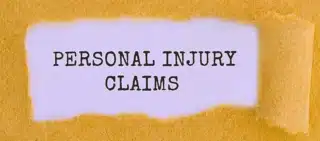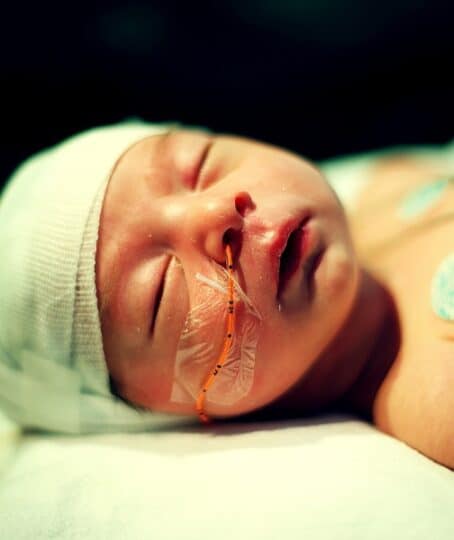
Overview of the Personal Injury Claim Process in Illinois No one expects to suffer an injury or get involved in...


When an infant is injured during labor and delivery due to the negligent actions of the attending healthcare provider, medical malpractice occurs. Birth injuries caused by medical malpractice can have severe consequences for both mother and child. Parents who suspect their, or their children’s, the birth injury was the result of a doctor or healthcare professional’s negligence should consult with an attorney to determine if pursuing a medical malpractice case is their best course of action.

Both mothers and babies can suffer birth injuries during delivery. Although most births in the United States occur without any significant difficulties, the few that do have complications can have devastating consequences for the baby and his or her family. Some common birth injuries in children are:
Brachial Plexus Palsy is an injury that occurs when the group of nerves around a baby's shoulders, called the brachial plexus, sustains damage. Damage to the brachial plexus may occur if the baby’s position is wrong during birth or a healthcare worker pulls on the baby’s arms during the delivery. Damage to these nerves can cause the baby to experience arm weakness or lose movement of the arms.
Pressure on a baby’s face during labor or birth may injure his or her facial nerves. The use of forceps during delivery may also cause facial paralysis. Paralysis is most noticeable when the baby cries and one side of the face does not move. The injury may also result in the baby being unable to close one of his or her eyes. If a bruised nerve caused the paralysis, it will likely improve within a few weeks. If a torn nerve is the cause of the paralysis, the baby may need surgery.
Babies may suffer a fracture of the clavicle or collarbone in some deliveries. These fractures usually heal quickly and require little intervention.
Hypoxic Ischemia is a condition that occurs when the baby suffers a lack of oxygen to the brain or reduced blood flow during delivery. It can cause brain disorders that range from mild developmental delays to severe medical issues, such as cerebral palsy or epilepsy. The severity of a baby’s medical issues usually depends on how long he or she was deprived of oxygen.
Cerebral Palsy refers to a range of neurological disorders that permanently affect body movement and muscle coordination. Although cerebral palsy affects movement, the problem is not in the baby's muscles. It is caused by abnormalities in the parts of the brain that control muscle movements. Symptoms of cerebral palsy include problems with movement and posture; seizures; problems with vision, hearing, or speech; changes in the spine; or joint problems. Parents may not realize a child has cerebral palsy until the child is two or three years old, or older.
Spinal cord injuries are much rarer than the other injuries on the list. However, the consequences are often catastrophic and can include decreased or absent movement, loss of reflexes, apnea or periodic breathing, and a lack of response to painful stimulation.
Unless a baby’s birth injury is severe and immediately obvious, it may be difficult for parents to recognize symptoms because newborn babies lack coordination and range of motion. However, there are some signs that a parent can look for if they are worried about birth injuries. Some symptoms of birth injuries include:
Parents may also try to recall their prenatal care and the birth to determine if there were any irregularities in their treatment leading to a possible birth injury. Actions during prenatal care and delivery that can be considered medical malpractice include:
Mothers can also suffer injuries during birth that can cause severe medical problems. They might suffer from blood clots, diabetes, hemorrhaging, infections, pre-eclampsia, severe vaginal tears, and uterine ruptures, among other complications. Some of these conditions can resolve themselves after the delivery, while others can be life-threatening. Mothers can also pursue birth injury medical malpractice suits when a healthcare provider causes them damage through negligence.
To determine whether a birth injury is an unavoidable accident or whether it was caused by medical malpractice, it is first necessary to understand what constitutes malpractice. Medical malpractice occurs when a doctor, hospital, or other health care professional causes harm to a patient through a negligent act. Negligence occurs when their actions fail to meet the relevant standard of care. For medical malpractice, the relevant standard of care is the same level that another healthcare professional in similar circumstances would use while treating the same patient.
If patients think medical malpractice caused their or their children's birth injury, they can sue to recover damages. To win a birth injury case, the injured party must prove the four elements of medical malpractice:
An injured patient may sue the doctors and healthcare workers who were negligent and the hospital that employs them. Although the negligent act of an individual healthcare worker may cause a birth injury, the hospital is often vicariously liable for that healthcare worker's actions. Hospital administrators are responsible for screening the doctors and other healthcare professionals they hire. They are also responsible for ensuring their employees receive appropriate, continuing training and provide an acceptable level of care to the patients. A hospital may be financially responsible for the consequences of one of its employee's negligence when the employee fails to use the required standard of care. Vicarious liability only applies when a doctor or healthcare worker is a full-time employee of the hospital rather than an independent contractor.
Proving each of these elements, either against an individual healthcare worker or against a hospital, can be complicated and require supporting evidence. The patient should begin gathering evidence as soon as possible if he or she suspects a healthcare professional's negligence caused a birth injury. He or she should gather medical records, witness testimony, and evidence of additional medical treatment. Patients who suspect a birth injury should engage a medical malpractice attorney as soon as possible after the delivery. People suffering a birth injury to themselves or their children may be too busy or too stressed to gather the necessary evidence or make a plan to move forward with a medical malpractice claim. A medical malpractice attorney can do the work of gathering evidence and expert testimony and relieve the patient of that burden.
The process of bringing, and winning, a medical malpractice case is long and arduous. It can be extremely stressful and takes a large number of resources. However, many families with a child or parent suffering from a birth injury need financial help to pay for medical bills, therapy, and other needs. The award from a medical malpractice case can help families with the financial burden that accompanies birth injuries. While some birth injuries are not serious, others will affect the baby or mother for the rest of his or her life.
As an example, by some estimates raising a child with cerebral palsy can cost $50,000 or more a year. Treatment for cerebral palsy can include:
Medications. Some medications can improve movement, reduce pain, or relax muscles. Parents may be able to administer their child’s medicine orally. However, some children may need their medicine administered by gastrostomy tube, as a patch, or by injection.
Physical therapy. The therapy can help the child gain strength, become more flexible, and gain better mobility. The child may also need specialized treatment programs, braces, splints, casts, or other devices that aid in mobility.
Occupational therapy. This type of therapy can help a child gain independence in performing daily tasks at home and school. The child may learn skills using a computer or technology that help further improve his or her independence. An occupational therapist may also help a child with cerebral palsy learn how to use adaptive equipment such as reachers, weighted spoons, and computer interfaces.
Speech therapy. Parents can use speech therapy to help a child overcome trouble with eating or swallowing. It can also help a child learn how to speak more clearly or to use communication devices such as voice generation software on an iPad.
Orthopedic surgery. Sometimes surgery is the best option to help reduce pain or prevent harmful changes in the shape or alignment of a bone or joint. It may help a child sit, walk, or move his or her arms more easily.
Although a child with cerebral palsy may not need all these medical interventions, the possible medications and therapies show how involved raising a child with special needs can be. Parents raising a child with a birth injury will incur large, ongoing medical bills. They will also spend an excessive amount of time looking after the child or ensuring that he or she receives the appropriate medical care and therapy. Often, one parent of a disabled child can not work because he or she must act as the child’s full-time caregiver.
An award from a birth injury medical malpractice suit can help families provide care for their loved ones and lighten the financial burden they will face. An award can include pain and suffering, past and future medical treatment related to the injury, and future lost income (or loss of future earning capacity).
A family with a child or mother suffering from a birth injury due to a doctor or healthcare professional’s negligent actions may be able to recover damages through a medical malpractice case. Medical malpractice cases are complicated and require extensive evidence, including expert testimony. A family seeking to recover damages for a birth injury should consult with a medical malpractice attorney for advice on the best strategy to pursue. The attorney can help families dealing with the consequences of a birth injury navigate the complicated process of bringing a medical malpractice case. He or she can also provide advice regarding when to settle and when to move forward with a trial, helping them recover an award that will support their loved one's care.

Overview of the Personal Injury Claim Process in Illinois No one expects to suffer an injury or get involved in...

Exploring Caps on Damages in Illinois Personal Injury Cases Illinois does not have laws capping damages in successful personal injury...

For one of the top Peoria law firms to manage your case, contact Strong Law Offices at (309) 688-5297. Top...